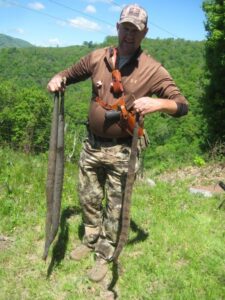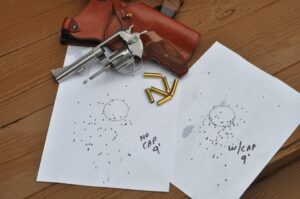
By John Markwell | Contributing Editor
One thing always seems to lead to another when it comes to gun projects.
A couple of years ago we purchased a Smith & Wesson Model 631 revolver at the Tulsa gun show. This is essentially a 4-inch barreled S&W Kit Gun, but it’s chambered for the .32 H&R Magnum cartridge. It was the gun and not the cartridge that we had a particular interest in as; a) we have a weakness for S&W Kit Guns and; b) 631s are relatively rare.
However, since the 631 was used it just begged to be shot. After using the little revolver and the .32 H&R Mag. cartridge in the field for a while we found the combination of a light and compact revolver and the mild .32 H&R round to be a pretty attractive package for general woods loafing and plinking; sort of a beefed up .22 rimfire magnum.
Over the last couple of years, we’ve developed several handloads for use in the little 631 and have also embarked on two more custom .32 H&R revolver projects involving a couple of Ruger Single Six single actions and some patience. More on those later.
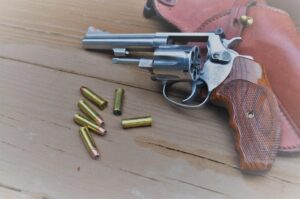
For general use and plinking we have a lead bullet load that launches a Rim Rock Bullets hard cast 125-grain Keith style lead SWC at a respectable 971 fps. For a small game/varmint round we have a load that sends a 100-grain Hornady XTP down range at just a hair over 900 fps. These two loads easily cover 98% of our needs when carrying/shooting the little .32 H&R cartridge in the field. As with many other handgun rounds we use, there is a need-gap of 2% or so that requires a special load. That 2% gap is usually filled by the great CCI Handgun Shot Shells. Only problem is, CCI does not produce a .32-caliber shot load.
Serious reloaders have crafted their own shot cartridges for use in handguns for many years and were actually doing so long before CCI brought their commercial versions to the market. The military had a .45ACP shot load during WWII and we have seen a couple of Colt SAAs with factory smooth bores for shot loads. Many folks used cut off .30-06 brass for .45 ACP shot loads and other creative methods to enhance the shot payload. But often these home-brewed shot loads were just put up in normal cases (mostly for revolvers) and these loads mimicked regular shotgun shells in construction, just on a smaller scale. Powder charge with a wad on top, then a load of shot topped by another wad (or a gas check), and all crimped in place. Pretty simple, huh?
Living in the rural Allegheny Mountains, pit vipers (Timber Rattle Snakes and Copperheads) are a fact of life. It’s not that these critters are a constant threat to ones’ safety but they are pretty commonly encountered as one goes about the daily business of working and recreating in the great outdoors. Most folks have no trouble dealing with the occasional venomous snake with either a rake, shovel, hoe, or even a good-sized stick. However, since we are kind of a gun guy, we often tote a handgun when working around our place or spending time afield just because we can and enjoy the company of a good handgun. Since we’ve been using the S&W 631 a fair amount lately, and with two more .32 H&R revolvers in the works, it was time to brew up a shot load.
Here’s how it went. We first re-sized and primed some once fired .32 H&R Magnum cases. We’ve read of folks using .327 Federal cases for shot loads as they are a bit longer and provide a bit more case capacity. But, for use in the .32 H&R they require an extra step to allow the longer case to seat in the shorter .32 H&R chamber; plus, we had no .327 Federal brass. For a powder we decided to use our old stand by for most of our handgun needs: Winchester’s 231.
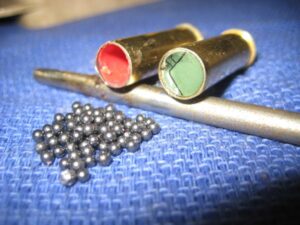
Deciding how much 231 to use was a pretty simple deal once we figured out the shot payload we were going to launch. This required assembling a few dummy test loads to figure out how much of what (powder/wads/shot, etc) would fit into the relatively small volume of the .32 H&R Mag case. Turns out the payload of #9 shot that would fit on top of the approximate powder charge weighed around 80 grains. Checking a few loading manuals, the recommended charge of W231 for a projectile in the 80-grain range averaged between 3 and 4.3 grains. We settled on using 3.5-grains of W231 to drive our 80-grain shot load. We surmise our velocity is in the 800 + fps range; we honestly didn’t want to risk a hit on our chronograph with the shot load to really find out.
Wads. What to do about wads? Historically many folks have used gas checks (cup up) for topping off the powder charge before adding the shot load to a home brewed shot shell. Then the shot load was capped with another gas check (with the cup down) and the case mouth was crimped, to hold the gas check in place, as the final operation. Not having any .32-caliber gas checks, we went looking around the gun room for a suitable material to emulate the gas checks used by some. A fiber or paper wad of some sort, like in the shotshells of yore, seemed like the ticket. Long story short, we ended up using the cover material found on a Rite-in-the-Rain all weather notebook. Wads were cut using a .32 H&R Mag case with the mouth beveled to a razor-sharp edge. The case was chucked in a portable drill and used to precisely cookie-cut a bunch of “wads” in just a few minutes.
There you have it. The simple home made shot shell for the .32 H&R Magnum: 3.5-grains of Winchester 231, top with one wad pressed in place with a #2 pencil, eraser down. Top that off with a charge of #9 shot to just below the case mouth, press fit another wad, crimp the case mouth and then seal with a dab of Gorilla Glue. Done!
But how do they shoot? In our testing on hand drawn snake heads on 8 1/2x 11” paper they shot pretty good patterns at 3, 6 and nine feet. We were satisfied this load would do the job. That is until we had lunch at an Arby’s and took note of the red straw in our tea. A light went on! Looks to be a .32 caliber straw!
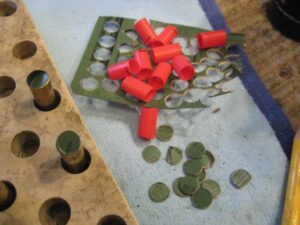
There’s a reason most real shotgun shells use plastic wads to encapsulate their shot charges. Hum??? It didn’t take long to reconfigure the home brewed shot shells incorporating a short section of Arby’s soda straw as a shot cap. Theoretically we thought, this should help prevent deformation of the pellets as they are driven down the rifled bore of the revolver leading to denser patterns and reducing bore leading. Well, the short story here is that using .75-inch sections of plastic straw as a shot capsule did tighten up the pattern density by a noticeable amount. Adding the section of straw to each cartridge reduced the volume for the number of shot by a bit, but the increased pattern density was worth it. Increased pattern density would also increase the affective range of the load. As far as bore leading goes, it’s doubtful we’ll ever shoot enough of these loads for that to be a problem.
So, there you have it. That’s our solution to coming up with a product that the shooting industry doesn’t provide. Our .32 H&R Magnum shot shells take a bit of work in the loading room but meet our requirement for a snake/rat/chipmunk and general pest load. Now our .32s (when the others are finished) will be able to handle 100% of the shooting problems we ask them to solve. If you have a handgun for which CCI does not make a shot shell using the above-described ideas, and a bit of caution can enhance the versatility of the gun. It ain’t rocket science, it just takes a bit of old-fashioned ingenuity and time. One final note on pit vipers and handgun shot shells. We are often asked how close you need to be to affectively dispatch snake with a handgun? Our answer has always been, “it depends on how brave you feel at the time and how big the snake is.” Test your loads on paper first.

